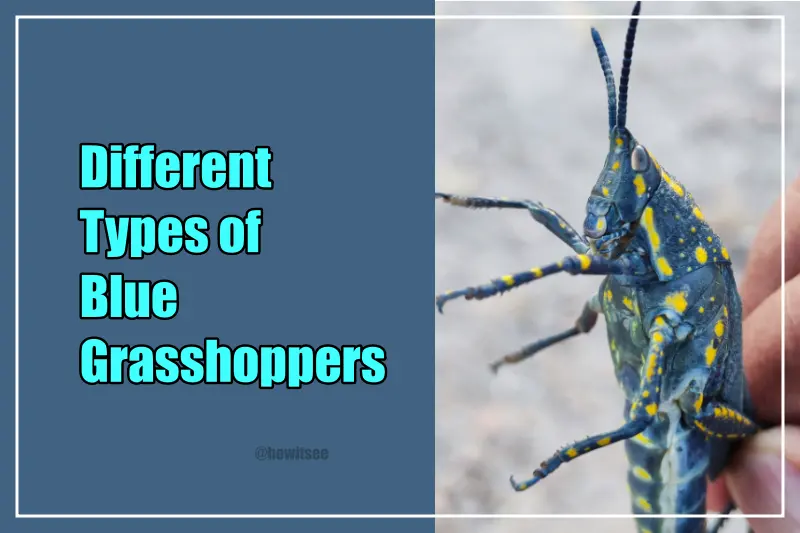Blue grasshoppers are an enthralling species of grasshopper with gorgeous blue colors on their bodies. Although blue is not a common hue among grasshoppers, these individuals stand out with their brilliant blue bodies or wings. In this article, we are going to talk about these Blue Grasshoppers.
10 Different Types of Blue Grasshoppers (With Identification & Pictures)
1) Chameleon Grasshopper
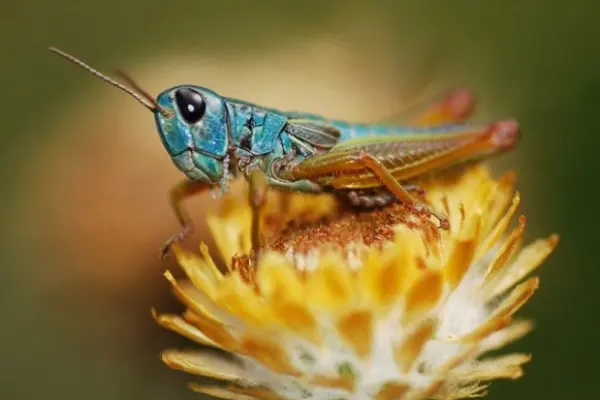
| Scientific Name | Kosciuscola tristis |
| Size | No Information |
| Location | Austrailian Alps |
| Identification | Blue body with dark blue spots |
A really extraordinary bug, the blue chameleon grasshopper captivates with its striking look and distinctive talents. It sticks out from its green and brown brethren thanks to its vivid blue body and exquisite patterning.
This grasshopper has a fantastic camouflage system that enables it to adjust to its environment with astounding accuracy. Depending on its surroundings, it can alter its color, going from a bright blue to muted tones of green or brown.
This amazing adaption not only makes it easier for it to blend in with its environment, but it also acts as a protection against potential predators. The blue chameleon grasshopper is a wonderful marvel of nature that exemplifies the animal kingdom’s boundless creativity and wonders.
2) Blue Legged Grasshopper

| Scientific Name | Metator pardalinus |
| Size | 49mm |
| Location | North America |
| Identification | Brown body with blue legs |
Metator pardalinus, sometimes known as the blue-legged grasshopper, is a remarkable bug. The unusual look of this grasshopper, notably its brilliant blue hind legs that contrast with its brown or green body, distinguishes it.
The grasshopper’s brilliant blue legs serve several functions. To begin with, they serve as a visual cue to possible mates, luring them during the breeding season. Second, they serve as a protection mechanism by frightening predators with their bright colors.
The blue-legged grasshopper is an expert jumper, capable of leaping great distances to avoid danger.
Its strong and powerful hind legs, paired with its distinctive blue coloration, make it stand out in the grasslands and meadows where it lives. It exemplifies the various and beautiful adaptations found in insect world.
3) Two-striped Grasshopper
| Scientific Name | Melanoplus thomasi |
| Size | 30-40mm |
| Location | North America |
| Identification | This grasshopper has bluish green body with red legs. |
Another blue grasshopper on the list is the Two-striped Grasshopper. As the name suggests, it has two unique blue or brown stripes that run over its body.
Generally, they can be found in yellowish-green color, but here we are mentioning Thomas’s Two-striped Grasshoppers that are perfectly blue in color with red legs.
Thomas’s Two-striped grasshoppers are a species of spur-throated grasshopper easily seen in Central America. They have various habitats, including grasslands, open fields, and even agricultural settings, and they primarily feed on different kinds of plants.
4) Blue Winged Grasshopper
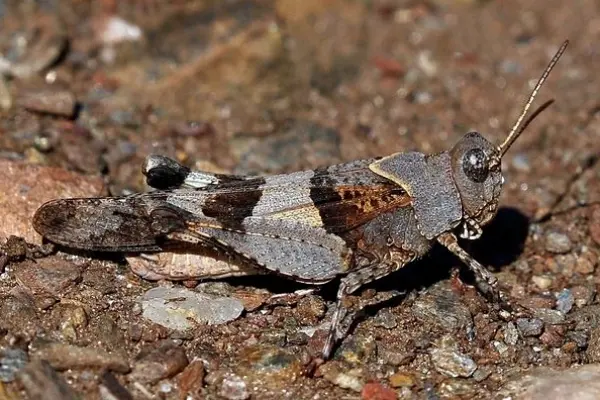
| Scientific Name | Oedipoda caerulescens |
| Size | 15-30mm |
| Location | Europe, North Africa and Asia |
| Identification | It has a brown body with blue wings |
The fourth one on the “Blue Grasshoppers” list is Blue Winged Grasshopper, recently rediscovered in the Maltese islands. These grasshoppers have beautiful blue wings with a wide black and white stripes.
The overall body is greyish-blue hue, and they have the ability to develop other colors depending on the substrate, like reddish brown, dark grey, or even yellow.
Predominately, males have blue colors to attract females. Blue Winged Grasshoppers have various habitats, including dunes, heathlands, grasslands on the sand, and sunlit limestone rocks.
However, in the past ten years, there has been a slight decline in their population due to an increase in human activities. Also, they are herbivores and mainly feed on different types of grasses.
5) Painted Grasshopper
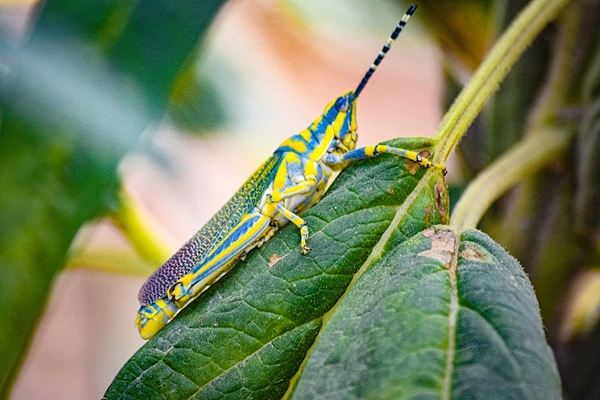
| Scientific Name | Poekilocerus pictus |
| Size | 60mm |
| Location | Indian Subcontinent |
| Identification | It has yellow body with blue strikes. |
Poekilocerus pictus, the painted grasshopper’s scientific name, is a fascinating bug that is native to areas of Asia, particularly India. The intriguing and brilliant look of this grasshopper, which resembles a multicolored piece of art, gives it its name.
A magnificent visual display is produced by the pattern of contrasting blue and yellow colors that cover its body. Its appearance is remarkable, but it also acts as a barrier against attack.
Potential predators are warned by the grasshopper’s vivid colors that it can be poisonous or repulsive. The painted grasshopper is a skilled jumper, moving through the air with agility on the strength of its powerful hind legs. It feeds on a range of plants as a herbivore.
6) Suassures Blue Winged Grasshopper
| Scientific Name | Leprus intermedius |
| Size | varying sizes |
| Location | Central and North America |
| Identification | It has a brown body with blue wings |
Blue-winged grasshoppers are a diversified species of grasshoppers distinguished by their blue-hued wings. Blue-winged grasshoppers are found all throughout the world, including North America.
These grasshoppers have brown or green bodies that act as efficient camouflage in their natural settings. Their iridescent blue wings are a stunning characteristic that serves several functions.
During mating, it serves as a visual signal, assisting males in attracting possible mates with vivid displays. Furthermore, the brilliant blue color may discourage predators or act as a warning that the grasshopper is toxic or unappealing.
It’s presence adds a visual element of curiosity to nature’s tapestry, showing the richness and beauty of the insect world.
7) Little Clown Grasshopper
| Scientific Name | Chromacris colorata |
| Size | |
| Location | India |
| Identification | It has a blue body with orange stripes |
The Little Clown Grasshopper, Chromacris colorata, is a fascinating and colorful insect found in the Americas’ tropical climates. It gets its name from its colorful and eye-catching coloration, which is reminiscent of clown clothing.
The Little Clown Grasshopper’s body is a rainbow of brilliant and contrasting colors, including red, yellow, blue, and green. Thus, these hues are frequently arranged in elaborate patterns, making each individual one-of-a-kind.
The Little Clown Grasshopper’s vivid color serves several functions. It serves as a visual cue to potential predators that it may be unappealing or toxic.
Furthermore, the brilliant hues may aid in species identification and mate appeal. The Little Clown Grasshopper, with its eye-catching look and lively behavior, contributes to the beauty of nature.
8) Blue Strip Winged grasshopper
| Scientific Name | Stenobothrus lineatus |
| Size | varying sizes |
| Location | Asia, Europe, and North America |
| Identification | It has a blue colored body |
The Blue Striped Wing Grasshopper, or Stenobothrus lineatus, is an eye-catching grasshopper species that can be found in a variety of grassy settings throughout Europe. It is renowned for its distinctive design and hue.
The Blue Striped Wing Grasshopper is an adult grasshopper that normally has a slim body and stunning blue stripes on its wings.
The grasshopper’s body color is primarily green or brown, and these blue stripes stand out against it, producing a striking contrast. When the wings are fully extended or in flight, the color of the wings is most noticeable.
Being a quick jumper, the Blue Striped Wing Grasshopper is frequently observed doing so. It primarily consumes plants and grasses, making it a herbivore.
9) Rainbow Grasshopper
| Scientific Name | Dactylotum bicolor |
| Size | 20mm |
| Location | Mexico, Texas and Africa |
| Identification | It has a blue body with yellow and orange stripes |
The Rainbow Grasshopper, scientifically known as Dactylotum bicolor, is a fascinating and visually appealing grasshopper species found in Africa. As the name suggest this grasshopper has different colors which gives it a rainbow color.
The mature Rainbow Grasshopper has a long, slender body. Its body is covered in brilliant colors that range from iridescent blues, greens, and purples to flaming reds, oranges, and yellows.
This remarkable color varies amongst individuals, resulting in a fascinating color mosaic. The vivid appearance of the Rainbow Grasshopper serves several functions, including species recognition, mate attraction, and possibly as a warning to predators.
This grasshopper is mostly herbivorous, eating a variety of plants and grasses. The Rainbow Grasshopper is a remarkable natural marvel, with its spectacular display of colors.
10) Robust Grasshopper
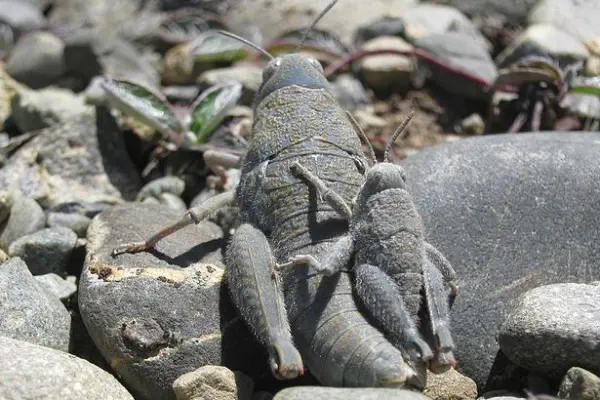
| Scientific Name | Brachaspis robustus |
| Size | 18-42mm |
| Location | New Zealand |
| Identification | It has blue body with orange spots |
Brachaspis robustus is a grasshopper species that is only found in the Mackenzie Basin of New Zealand’s South Island. Although it is related to grasshoppers, it is not a good jumper and relies on camouflage to avoid predators.
The presence of invasive mammals such as stoats, hedgehogs, and rats puts the species at risk. Adult males can jump up to 1.5 meters many times, according to New Zealand entomologist Dr Tara Murray, but their landings are frequently unsuccessful.
Females have shorter jumping distances due to their weight. These grasshoppers freeze as a protection strategy, and when they do jump, they frequently land awkwardly on the ground.
Conclusion
In conclusion, blue grasshoppers are a fascinating component of the natural world. Their remarkable color and adaptations set them apart from their green and brown grasshoppers.
The color may appear to be solely decorative at first glance, it serves as an important survival strategy, offering concealment or warning signals to predators. Because their brilliant colors are determined by factors such as genetics, habitat, and adaptability. These stand out in nature and leave the viewer awestrucken.
Also Read:

I am a person who effortlessly combines creativity, hard work, and a strong interest in nature. My writing takes you on incredible journeys where science and imagination come together. I am driven by a deep curiosity to understand the wonders of life, and dive into the details of biology with thorough research and a genuine appreciation for nature. My articles are full of vivid descriptions and fascinating facts, making the world of biology come alive. Whether I am writing articles, essays, or fiction, my work sparks curiosity and shows the incredible beauty of our natural world.
